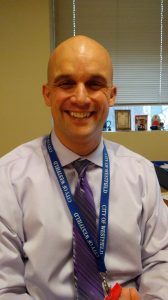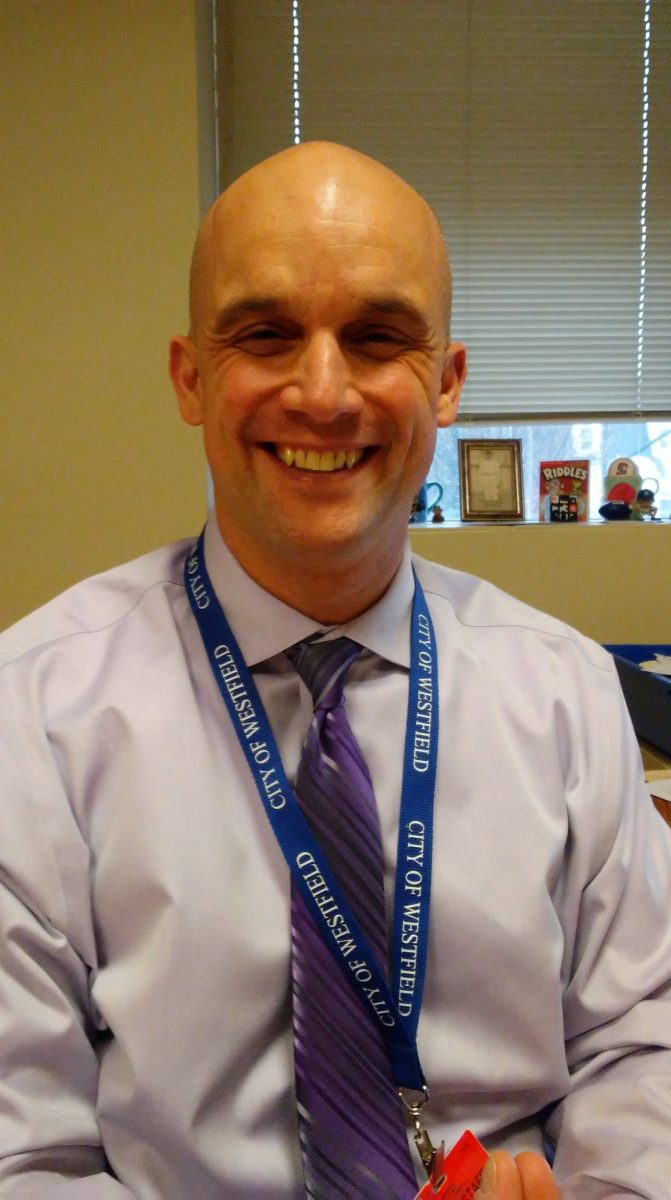
Christopher J. Rogers, director of student interventions for the Westfield Public Schools. (WNG File Photo)
WESTFIELD – Director of Student Interventions Christopher Rogers and members of the district’s new attendance task force reported on their initial findings and early progress to the School Committee on Dec. 16.
Rogers began by explaining the data. He said missing 18 days or more — 10 percent of the school year – is considered chronically absent.
Nationwide, 14% of students are chronically absent 15 days or more. Rogers said there is an impact on grades when students are absent five days or more in a year, and it is a stark comparison which begins as early as kindergarten, and extends across all grades, creating a cumulative effect.
Chronically absent students exhibit higher rates of delinquent and risk taking behaviors, and are at an increased risk for involvement in the criminal justice system. “This is not just a Westfield problem, but a nation-wide problem,” Rogers said
Westfield attendance rates have been trending downwards over the last few years, and is below the state average of 94.6% attendance. Westfield schools had dipped below 94%, with the average number of days absent last year at 10.7 days, more than the state average of 9.6 days. Rogers said this is why the district put together a task force on attendance.
“There is a little bit of a sense of urgency,” Rogers said, adding that the Department of Elementary and Secondary Education (DESE) has begun to judge schools on chronic absenteeism. The percent of students that are chronically absent in Westfield is 16 to 17%, compared to 13% statewide.
Westfield Middle School Assistant Principal and task force member Jessica Kennedy said there is now a district-wide policy, which includes all schools.
“Our goal is to generate enthusiasm among students to come to school, and reduce chronic absenteeism by no less than 3%,” Kennedy said, adding that they have teams of educators reviewing the data.
Rogers said before this was something that individual schools looked at. “We all need to start doing things as a team, rather than individual schools attacking it,” he said.
School Committee member Diane Mayhew, who is also on the task force, said they are looking at attendance in every school in the district.
Staff teams, including nurses and teachers are meeting weekly and bi-weekly, and looking into the root causes of student absences, such as families needing support. The task force meets monthly, and is digging deeper into the data.
Rogers said when he first started as principal of North Middle School, their policy was punitive and reactive. “Now we’re looking at a more proactive model,” he said.
Kennedy said they are sending letters home, congratulating good attendance. They are also surveying students. “All stakeholders have a stake in this,” Kennedy said, adding, “Research shows you can’t punish kids into wanting to come to school. You need to teach accountability.”
Rogers called the earlier data “doom and gloom.”
“The good news is right now, we are at our goal,” he said, adding that new data as of Dec. 13 for pre-k – 13 was at 95.03% attendance, and for grades 1 to 12, 95.06%.
However, he acknowledged that they are only 40% of the way through schools. He said last year, at the end of the year, Westfield had 16.7% of students who were chronically absent. As of Dec. 13, that percentage is at 13.21 to 13.28% chronic absenteeism.
“It’s not as daunting, we’re fixing this,” Rogers said.
Westfield High School Principal Charles Jendrysik said at the high school, they have been focusing on reducing the drop-out rate, which is now just above one percent, but he said the students still don’t come every day, and their absentee numbers “tanked” last year. The state grades the schools on both measures.
Rogers said one of Superintendent Stefan Czaporowski’s main focuses is on making the senior year more relevant, with increased opportunities for college credits, job shadowing and internships. He said it’s about building relationships, and making sure that school is relevant for students, especially seniors.
“Yes, we have to be cognizant of the state, but our goal is to have kids come to school because they want to,” Czaporowski said.
“If we build it, they will attend,” Rogers added.
In response to questions from the School Committee, Rogers said students must be in school 50% or more of the day to be considered present. There is a difference between excused and unexcused absences, but he said the state doesn’t care. Students that are out on field trips or at events, such as recent choir performances, are marked as present but not in the building
Rogers said students with long-term illnesses who have tutors are also given credit for being present outside of the building.
“We’re not going to reach every child and figure out why every child doesn’t attend. In some schools with low enrollment like Abner Gibbs, if two children are absent, the percentage spikes. There is a lot that goes into the data. It’s a great group of people on the task force. I enjoy being a part of it,” Mayhew said.
“We’re keeping kids in school; they’re not dropping out. Now we have to work on attendance,” added School Committee vice-chair Ramon Diaz, Jr.
“The work of the Attendance Task Force and our district-wide focus on improved student attendance have produced gains in this area. But, like most things done well, this is a long-term system focus for improvement, not an overnight quick fix,” Rogers said following the meeting.







